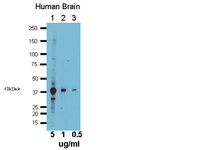AB15644 Sigma-AldrichAnti-HuD Antibody
This Anti-HuD Antibody is validated for use in WB for the detection of HuD.
More>> This Anti-HuD Antibody is validated for use in WB for the detection of HuD. Less<<Produits recommandés
Aperçu
| Replacement Information | |
|---|---|
| Replacement Information | AB05644 is a recommended replacement for AB5971 |
Tableau de caractéristiques principal
| Species Reactivity | Key Applications | Host | Format | Antibody Type |
|---|---|---|---|---|
| H, R, M | WB | Rb | Purified | Polyclonal Antibody |
| References |
|---|
| Product Information | |
|---|---|
| Format | Purified |
| Control |
|
| Presentation | Purified rabbit polyclonal in buffer containing 0.1M Tris-Glycine (pH7.4) 15mM sodium chloride with 0.05% sodium azide. |
| Applications | |
|---|---|
| Application | This Anti-HuD Antibody is validated for use in WB for the detection of HuD. |
| Key Applications |
|
| Physicochemical Information |
|---|
| Dimensions |
|---|
| Materials Information |
|---|
| Toxicological Information |
|---|
| Safety Information according to GHS |
|---|
| Safety Information |
|---|
| Storage and Shipping Information | |
|---|---|
| Storage Conditions | Stable for 1 year at 2-8ºC from date of receipt. |
| Packaging Information | |
|---|---|
| Material Size | 100 µg |
| Transport Information |
|---|
| Supplemental Information |
|---|
| Specifications |
|---|
| Global Trade ITEM Number | |
|---|---|
| Référence | GTIN |
| AB15644 | 04053252672460 |
Documentation
Anti-HuD Antibody FDS
| Titre |
|---|
Anti-HuD Antibody Certificats d'analyse
| Titre | Numéro de lot |
|---|---|
| Anti-HuD - 2445029 | 2445029 |
| Anti-HuD - NG1556181 | NG1556181 |







